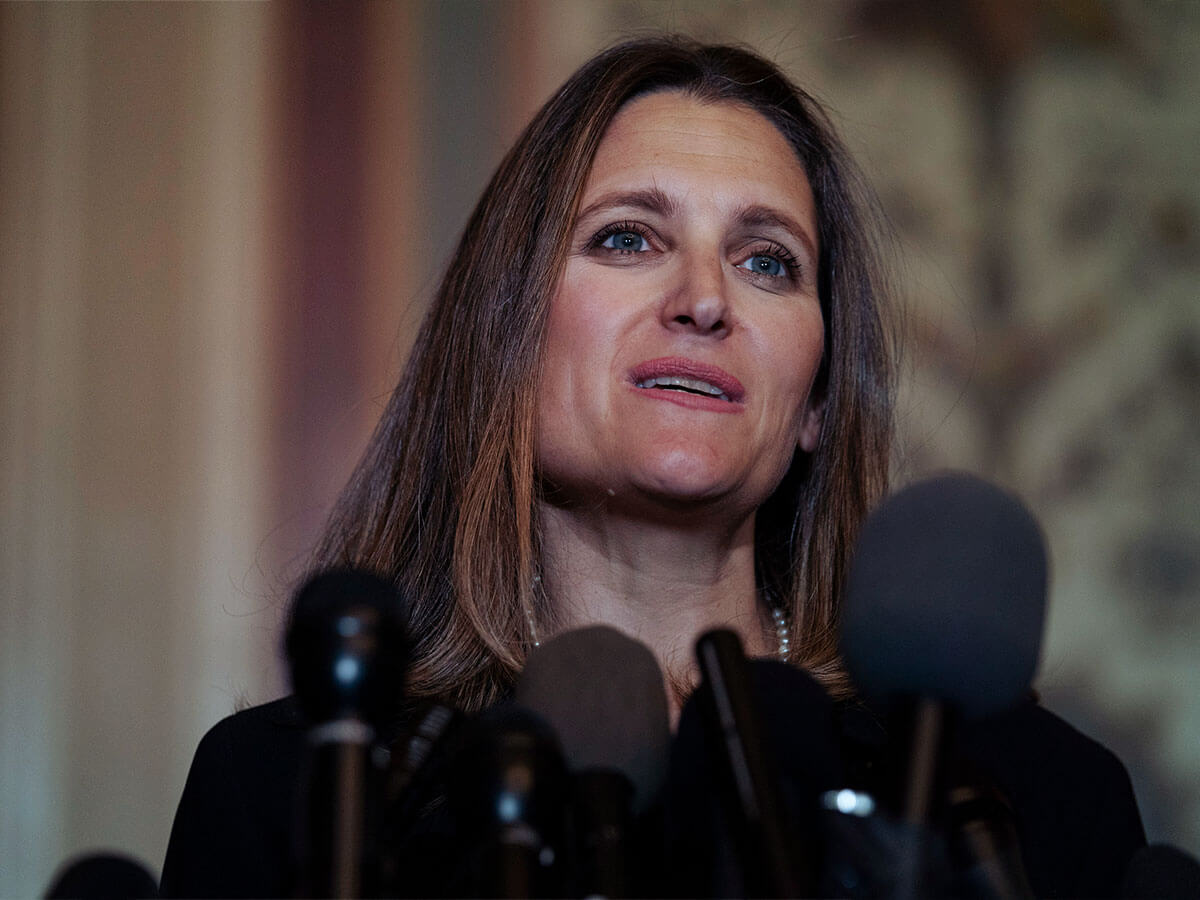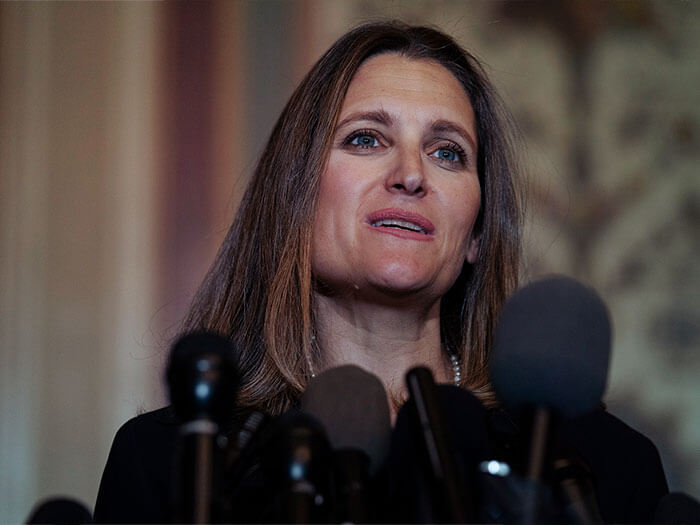
Federal budget prioritizes post-pandemic recovery and the green economy
 On April 19, Deputy Prime Minister and Minister of Finance Chrystia Freeland (pictured at an event in Washington, D.C., on June 13, 2018) unveiled the 2021 federal budget (Getty Images/Toya Sarno Jordan)
On April 19, Deputy Prime Minister and Minister of Finance Chrystia Freeland (pictured at an event in Washington, D.C., on June 13, 2018) unveiled the 2021 federal budget (Getty Images/Toya Sarno Jordan)
The federal budget—unveiled by Deputy Prime Minister and Minister of Finance Chrystia Freeland on April 19—addressed three distinct challenges Canada currently faces: conquering COVID-19, accelerating out of the recession and building a more resilient nation for the future.
With a projected deficit of $354.2 billion for 2020-21 and $154.7 billion for 2021-22, the budget focuses on continued support for Canadians most impacted by the pandemic. Support measures include extended COVID-19 relief programs and job creation, small business digital adoption, investment in young Canadians and the acceleration towards a clean, green economy.
“This budget is about finishing the fight against COVID. It’s about healing the economic wounds left by the COVID recession,” said Freeland in her speech.
“It’s about meeting the urgent needs of today, and about building for the long term.”
“The federal government’s continued focus on immediate short-term needs remains essential as the country faces alarming pandemic numbers in certain regions,” says Charles-Antoine St-Jean, president and CEO at CPA Canada. “We applaud the extension of current support programs along with additional investments to create jobs, support the most affected sectors and assist the transition to net-zero emissions.”
Here are some highlights from the 2021 federal budget:
1) ‘BUILDING BACK BETTER’ INITIATIVES
Measures providing immediate support to Canadians and their businesses, while seeking to sustain families and provide incentives for small businesses to innovate in the long term, shows commitment to the “building back better” theme, says CPA Canada.
- Continuing Covid-19 support
Measures include extended access to the Canada Emergency Wage Subsidy (CEWS), Canada Emergency Rent Subsidy (CERS) and flexible Employment Insurance (EI). Additionally, the Canadian Recovery Hiring Program (CRHP) encourages eligible employers to hire laid off or new employees.
- Jobs, skills and youth investment
With approximately 300,000 Canadians still out of work due to the pandemic, a Throne Speech commitment of creating one million jobs by year’s end, and approximately 500,000 new training and work experiences, remains the goal.
Additionally, the Canada Workers Benefit will invest $8.9 billion over six years to assist one million low-income earners and lift 100,000 people out of poverty. There is also a $15-an-hour federal minimum wage proposal.
An investment of $5.7 billion will be made over five years in Canada’s youth, with measures meant to make education more affordable, create jobs and provide debt repayment assistance through an extension of the Canada Student Grant and a waiver on federal student loans until March 2023.
- Supporting women’s re-entry into the workforce
Given the pandemic’s impact on women who have lost their jobs or had to leave the workforce, Canadian families are also prioritized with the proposed introduction of a National Childcare System—a $30 billion investment over five years, reaching $8.3 billion annually on a permanent basis. “Five years from now, parents across the country should have access to high-quality early learning and childcare, for an average of $10 a day,” said Freeland.
- Helping SMEs innovate
Canada’s small businesses must stay abreast of innovation to remain globally competitive. A $4 billion investment would help thousands of SMEs invest in new technologies, while programs such as the Canada Digital Adoption Program and the Venture Capital Catalyst offering financing would help them do so. (The first would provide grants, advice and training to adopt new technologies and the second would fund the growth of innovative Canadian companies.)
“While immediate attention must focus on COVID-19 and its fallout, it is encouraging to see the government looking long-term to prepare our economy and society for a very different post-pandemic world,” says Gord Beal, vice-president of research, guidance and support at CPA Canada. “This is to be accomplished by incentivizing business investment that will help the country remain competitive, innovative and sustainable.”
2) FOCUS ON TAX
As anticipated by CPA Canada, no major changes were made to tax rates in general, but some new taxes were proposed.
“In our pre-budget submission, we encouraged the federal government to ensure any tax changes would be simple, principled and disciplined and to avoid tax rate increases if possible,” says Bruce Ball, vice-president of taxation at CPA Canada. Although some detailed changes were included, they either won’t apply broadly or immediately.
In addition to the extension of the CEWS and CERS and the new CRHP, other changes worth noting include:
- Capital expenditure deduction
Canadian-Controlled Private Corporations can immediately expense certain capital expenditures, effective for property acquired after April 19, 2021 and put into use before 2024.
- Interest deductibility
For taxation years beginning on or after Jan. 1, 2023, larger corporations, trusts, partnerships and branches will be subject to interest expense restrictions based on income before interest, taxes, depreciation and amortization (EBITDA), determined on a tax basis.
- Tax administration
Several new tax administration rules introduced will give the CRA new tools, such as more rigorous reporting requirements and strengthened anti-tax avoidance rules. Some of the proposals are subject to a consultation. The CRA will also receive additional funding of approximately $300 million over five years to deal with tax evasion and unacceptable tax avoidance.
- Other taxes introduced
An annual one per cent vacancy tax on the value of residential properties deemed vacant or underused was announced, applying to owners other than Canadian citizens or permanent residents. Also, a new luxury tax will apply on vehicles and aircraft priced over $100,000 and on boats priced over $250,000. Both taxes are effective Jan. 1, 2022.
For more information on the tax changes included in the budget, see our tax highlights summary.
3) SUSTAINABILITY FOR THE FUTURE
According to CPA Canada, preparing the Canadian economy and society for a post-pandemic world requires a renewed agenda that embraces and is committed to digital and sustainable change.
- Net-zero emissions goals
The budget announced $17.6 billion to fight climate change and fuel a green recovery, with climate targets ramped up to reduce Greenhouse Gas (GHG) emissions by 36 per cent (from 2005 levels) by 2030. The longer-term goal is to reach net-zero emissions by 2050.
Another $5 billion (in addition to $3 billion announced in December) over seven years, beginning 2021-22, will be invested in the Net Zero Accelerator to help companies reduce their GHG emissions.
In order to support job growth and clean technology manufacturing, general corporate and small business income tax rates for companies that manufacture zero-emission technologies will be reduced by 50 per cent starting in January 2022.
- Greener homes
A $4.4. billion investment will provide more than 200,000 homeowners with interest-free loans up to $40,000 to retrofit their homes based on an Energuide energy assessment.
“CPA Canada welcomes the measures in Budget 2021 to accelerate the transition to a clean economy,” says Beal. “However, the government must remain committed to addressing the concerns and hurdles faced by various sectors during this critical transition.”
DEEPER INSIGHTS ON FEDERAL BUDGET 2021
Read CPA Canada’s federal budget analysis and tax highlights and learn more about the government’s plan for a resilient economic recovery.